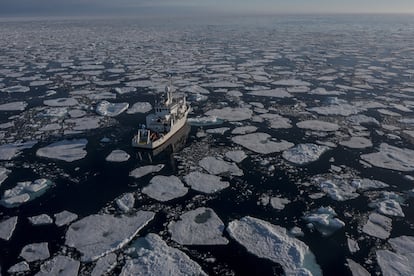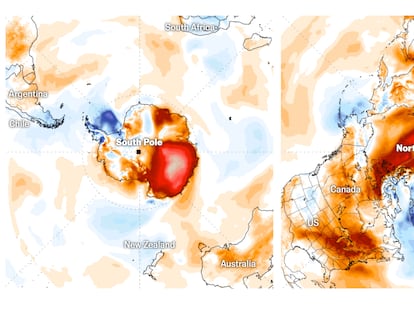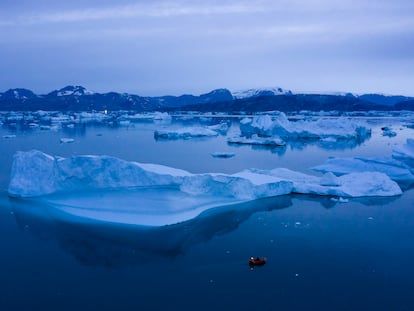The Arctic is set to completely melt for the first time within two decades
Satellite observations and a new climate model predict that the North Pole will lose all its ice each September

The ice that covers the Arctic reaches its low point each September, thanks to the warmth of the boreal summer. Since the end of the last century, the minimum is ever scarcer. According to NASA data, based on several of its satellites, the polar ice cap has been decreasing at a rate of 12.6% every decade since 1980. But climate variability itself makes it difficult to know when the entire Arctic Ocean will be water. Now, a study supported by observations from NASA and ESA satellites and a sophisticated climate model predicts that the first ice-free September will arrive between 2030 and 2050. And if greenhouse gas (GHG) emissions are not reduced, by 2100 the Arctic region will be ice-free for almost half a year.
Until the beginning of the century, trying to navigate the Northwest Passage —which connects the Atlantic Ocean with the Pacific Ocean through northern Canada)— was an adventure only possible in summertime and on board an icebreaker ship. The situation was somewhat better in the Northeast Passage, through the far north of Russia, where ships could navigate a couple of months out of the year. Today, both routes are relatively safe in summer, so much so that there are now tourist cruises on old icebreakers. But the Arctic Ocean resists circumnavigation. Even today, the Wandel Sea, the portion that connects to northern Greenland, remains frozen year-round. But according to a new study published today in the scientific journal Nature Communications, ships could even reach this area and the very center of the North Pole in just a few years.
“We see that the Arctic Ocean will be free of ice in summer between 2030 and 2050 in all the emission scenarios that we consider,” says Seung-Ki Min, co-author of the study and researcher at the Climate Change Research Laboratory of the University of Pohang, in South Korea, in an email. Future emission scenarios assume that the 2º of extra warming approved in the 2015 Paris Agreement will not be exceeded. This is the most optimistic scenario, so it seems that the thaw is inevitable. But it also means that, as Min says, “we can avoid a summer ice-free Arctic if we can cut GHG emissions more aggressively, like the 1.5º warming alternative path.” The problem is that, according to various studies, this limit on the increase in global average temperature has already been exceeded regionally. It could be exceeded globally in less than five years.
The study led by Min is based on the evolution of Arctic ice followed by various satellites, with data dating back to 1979 and up to 2019. One of the contributions of these 40 years of data is that, at least since the end of the 1990s, the polar cap loses ice every month, not just in the summertime. Since the end of the last ice age, the annual cycle of the Arctic followed the same pattern: the extent of the Arctic sea ice reached its maximum extent between March and April, to decrease in the following months, until its minimum between September and October, when it returned to start the cycle. But all the data indicates that the frozen portion of the ocean is getting smaller every March. It loses ice even in the coldest years.
“Previous work had looked at melting throughout the year, but our study confirms that the decline in Arctic sea ice in all months is mainly due to increases in human-induced greenhouse gases,” Min said. That is the study’s other major contribution: the confirmation of human responsibility. The Sun’s rays and heat are what melt the Arctic sea ice. But there are agents that can mitigate or intensify the solar radiation. Volcanic emissions, a natural atmospheric, consists of particles that cool off the atmosphere. Particles emitted from industry, cars and human heating also have their role. What the researchers have seen is that neither natural nor artificial particles are decisive: their cooling capacity cannot counteract the warming caused by carbon dioxide (CO₂) and the rest of the GHG.
The deputy director of the Institute of Oceanography at the University of Hamburg, Dirk Notz, is one of the leading experts on Arctic ice dynamics. In fact, he was one of the main authors of the sixth and last report of the Intergovernmental Panel on Climate Change (IPCC) and co-author of the section dedicated to the ocean, cryosphere and sea level. Notz is also a co-author of the new study on Arctic melting. He emphasizes humans’ responsibility: “We quantified the human impact on the massive loss of sea ice observed in the Arctic by up to 90%. This means that almost all of the melting that we have observed in recent decades has been caused by us humans.”
The authors of the paper used the latest climate modeling system, known as CIMP6. It requires great computing power and is capable of running several climate models at the same time, with a huge amount of data. To validate their results about the future, they compared those obtained by CIMP6 over the last 40 years and compared them with the real ones recorded by the satellites. “We saw that under all considered future scenarios, including the most optimistic scenario with substantial reductions in greenhouse gas emissions, the Arctic will be ice-free in September before 2050. This means that it is already too late to continue to protect the Arctic summer sea ice as a landscape and as a habitat: it will be the first major component of our climate system that we will lose due to our emissions.”
Although going beyond 2050 introduces more uncertainty, things will only get worse as the century progresses. The study predicts that, by 2100 and in the worst of the expected climate scenarios (in which GHGs are not reduced and the current rate of emissions is maintained), the Arctic will be without ice between May and October. The consequences of half a year without an Arctic ice cap would be far-reaching.
Despite what it may seem, the melting ice will not lead to a rise in sea level: unlike the land ice accumulated in Greenland or Antarctica, the Arctic ice is already in the water. But so many months without ice will accelerate climate change: frozen water has the largest albedo effect in nature after snow. That turns the North Pole into a giant mirror that reflects much of the solar radiation, cooling the region. But, thawed, a sea enriched by oxygen from fresh water darkens, absorbing more of the sun’s energy. So the melting ice increases global warming.
The environmental consequences have already been observed since the beginning of the century. Many marine mammals, such as seals, need a minimum amount of ice to breed and rest; arctic foxes and bears require ice to hunt. In principle, an ice-free Arctic Ocean for half the year could be good for the large marine mammals, the whales. But after the thaw, humans will arrive: shipping companies, mining companies, fishing boats, tourist cruises. The growing thaw is causing geopolitical reconfigurations that could reshape a large part of the world order.
“An ice-free Arctic Ocean means that competition for resources (fishing, oil and gas exploration) and shipping along what China calls the Polar Silk Road could become a reality sooner than expected,” says Kristina Spohr, Professor of International History at the London School of Economics. From Berlin, where she spoke on a panel on Russia, the war in Ukraine and the Arctic, Spohr says that “there will be more tension between what is considered international and national open waters. International waters must be governed in a new way, but national waters and ports will pose security concerns and therefore we will see more militarization. It will also attract non-Arctic players such as investors in ports and other infrastructure and mining resources (China, but also Japan, Singapore, South East Asia, India and European countries).”
For this geopolitics expert, “the melting of the Arctic and the thawing of the world order, due to climate change, the war in Ukraine and tectonic changes in the international balance of power, as China and Russia push for a multipolarity beyond the rules imposed after the fall of the [Berlin] Wall, carries risks for the indigenous peoples of the Arctic, for the ecology, regional flora and fauna and the situation of the region in general.” The region, as Spohr recalls, “has been considered a zone of exceptional peace since the late 1980s,” an area protected by ice.
Sign up for our weekly newsletter to get more English-language news coverage from EL PAÍS USA Edition
Tu suscripción se está usando en otro dispositivo
¿Quieres añadir otro usuario a tu suscripción?
Si continúas leyendo en este dispositivo, no se podrá leer en el otro.
FlechaTu suscripción se está usando en otro dispositivo y solo puedes acceder a EL PAÍS desde un dispositivo a la vez.
Si quieres compartir tu cuenta, cambia tu suscripción a la modalidad Premium, así podrás añadir otro usuario. Cada uno accederá con su propia cuenta de email, lo que os permitirá personalizar vuestra experiencia en EL PAÍS.
¿Tienes una suscripción de empresa? Accede aquí para contratar más cuentas.
En el caso de no saber quién está usando tu cuenta, te recomendamos cambiar tu contraseña aquí.
Si decides continuar compartiendo tu cuenta, este mensaje se mostrará en tu dispositivo y en el de la otra persona que está usando tu cuenta de forma indefinida, afectando a tu experiencia de lectura. Puedes consultar aquí los términos y condiciones de la suscripción digital.











































